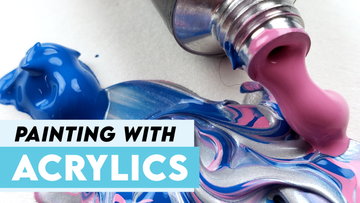Now that you have the supplies, let’s start painting with acrylics. Let’s learn a little bit more about them, and talk about tips and painting techniques you could try.
What are Acrylics?
Acrylic paint is usually made up of two components: the pigment and the binder.
However, you can’t just slap pigment and binder together to create the acrylic paint, so it’s a bit of a balancing act. A few things are added to the mixture to create a usable paint. These include: emulsifiers to prevent the polymer solids from binding together, dispersants to keep the pigments from clumping, wet-edge agents to regulate the drying time, and thickeners to create the buttery texture of the acrylic paints.

How to use Acrylic Paints
For the most part, you won’t need too many things to get started with acrylic painting. A lot of the prep time with acrylics, will be spent pre-mixing your paints.
Aside from the paint itself, you’ll need some paintbrushes, a jar or two of water, a palette to mix your paints on, a rag or paper towel for wiping your paintbrushes onto, and canvas, wooden board or canvas panel to paint on.
Time to prep those paints! Grab the colors you want to paint with, or the paints you want to mix together, and squeeze them out onto a palette. You can either mix them together using a palette knife, or your paintbrush. Make sure to mix a little more paint color than you think you’ll need. It’ll prevent you from having to mix more later, and risk not mixing the exact same color. Work quickly though! Acrylic paints dry relatively fast.
Now that you have your paints all mixed and ready to go, it’s finally time to paint.
When you work in acrylics, you’ll want to work in layers. The first layers should be thinned down with either water or a thinning medium, to help plan out your painting.
You can use your thinned down paint as a tool for sketching your piece, and as you add layers it won’t show through. This is called an underpainting, and it’s a great starting off point.
Because of the opaque nature of acrylics, it’s very easy to correct any mistakes you might make. All you have to do is let the problematic layer dry, and go back over it afterwards.
As you layer your paints, you’ll want to work more and more opaquely, using more paint and less water or medium than your previous layers. You should let each layer full dry before starting a new layer, unless you are wanting to work wet into wet.
Something beginners might find frustrating about acrylic paints is blending. Since acrylic paint dries quickly, it can be hard to make seamless blends.
There are mediums which you can add to your paints to help, which will be covered a bit later, or you can always use water to prolong the drying time. You’ll only need a tiny bit of water, which you can put into a spray bottle and gently mist to keep your paint damp. Don’t use too much, or you risk making your paint run and bleed onto the canvas. Another thing that can help with blending, is a dry, fluffy paintbrush, and a light touch.
Different Acrylic Painting Techniques
There are many different techniques you can play with, when using acrylics, and these are a few of them. Try them out for yourself! First off, there is dry-brushing. This is a very simple technique, and only requires a bit of paint, and a dry paintbrush.
Wet on Wet
A great method for blending is the wet into wet technique. This method is where you keep adding paint to already wet layers, and blend them into each other. This technique can be handy, but it is easy to build up too much paint. Be careful not to over blend, as your painting can get muddy.
Washing
The next technique to try is called, washing. Basically, you’ll want to water your paint down, to a watercolor consistency. This is great for soft effects like watercolor, that dry to be permanent.
Stippling
Another great technique is stippling. Stippling is very easy to do, and requires lots of dotting of your paintbrush onto the canvas, to create texture.
Sponging
Similar to stippling, is a technique called sponging. This can be achieved by dabbing a sponge onto your painting surface, to create different and interesting shapes and textures.
Impasto
Next technique we’re going to talk about is called impasto. It’s a very fun technique, where you add thick amounts of paint in strokes with a palette knife. It’s a great way to add texture to any painting.
Glazing
Glazing is also a fantastic technique to try. By mixing a glazing medium with acrylic paint, you create a transparent film to glaze over other colors, tinting them and creating a stained-glass effect.
Detailing
The last technique is something you might be familiar with, and that is detailing. Detailing is when you use a fine paintbrush to add finishing touches to a painting.
Now, grab your acrylic paints, and try some of these tips and techniques for yourself!
Article by McCaela Gates
Made especially for MyArtscape



